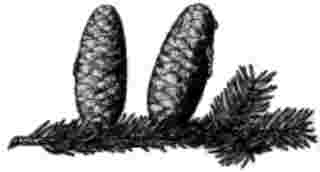
Balsam fir (3). |
Abies balsamea
(Linnaeus) Miller 1768
Common NamesBalsam fir, blister or balm-of-Gilead fir (4); eastern fir or Canada balsam (3); sapin baumler (7).Taxonomic notesSyn: Pinus balsamea Linnaeus 1753 (7)."Balsam fir is frequently segregated into two varieties (e.g., Scoggan 1978-1979) based on whether the bracts are included (var. balsamea ) or exserted (var. phanerolepis Fernald), the latter considered by Liu (8) to be a hybrid between Abies balsamea and A. fraseri . Lester (9) demonstrated, however, that bract length may vary within a cone, annually, and from tree to tree. Nevertheless, a tendency exists for the exserted variety to be found most commonly from Newfoundland south through New England (Hosie 1969; Jacobs et al. 1984); it is not found west of Ontario. Western populations lack 3-carene and have other minor chemical differences separating them from eastern balsam fir (Zavarin and Snajberk 1972; Hunt and von Rudloff 1974). Morphologic variation in balsam fir has been studied mainly east of Ontario; the populations to the west have been ignored for the most part, although they may yield stronger evidence for species subdivision" (7). "In Alberta, populations intermediate between western Abies balsamea and A. bifolia (Moss 1953; Hunt and von Rudloff 1974, 1979) may be classified as A. balsamea × bifolia . In West Virginia and Virginia, populations of balsam fir tend to be more similar to A. fraseri than are more northern populations (Jacobs et al. 1984)" (7). DescriptionA narrowly conical tree 12-23 m tall, 10-60 cm dbh, with a spire-like crown. Bark gray, thin, smooth, in age often becoming broken into irregular brownish scales. Branches diverging from trunk at right angles, the lower often spreading and drooping. Twigs mostly opposite, finely pubescent, yellow grey-brown or green-brown. Buds hidden by leaves or exposed, brown to reddish-purple, conic to globose, scales slightly pubescent, 9-11 mm in diameter, resinous, apex acute; basal scales short, broad, nearly equilaterally triangular, glabrous, resinous, margins entire, apex sharp-pointed. Needles 1-ranked (particularly on lower branches) to spiraled, curved upwards on branchlets exposed to full sun; cross section flat, grooved above, keeled below, shiny dark green above, 12-25 mm long by 1.5-2 mm wide, green or grey-green below; stomata in 0-4 rows at midleaf above, these more numerous toward leaf apex, with (4-)6-7(-8) stomatal rows on each side of midrib below; base twisted; odor pinelike (copious ß-pinene); apex slightly notched to pointed; resin canals large, ± median, away from margins, midway between abaxial and adaxial epidermal layers. Male cones 15mm long, at pollination red, purplish, bluish, greenish, or orange. Female cone resinous, sessile, apex round to obtuse, cylindric to broadly ovoid, 4-10 cm long by 1.5-3.75 cm wide, blue-grey-green or purple turning grey-brown or violet-brown; scales scales ca. 1-l.5 × 0.7-1.7cm (relationship reversed in more western collections), finely pubescent; bracts included or exserted and reflexed over scales. Seeds triangular, 3-6 × 2-3mm, body brown; wing about twice as long as body, brown-purple; cotyledons ca. 4. 2 n =24 (1, 7).RangeCanada: Alberta, Saskatchewan; Manitoba, Ontario, Québec, Prince Edward Island, New Brunswick, Nova Scotia, Newfoundland; France: St. Pierre and Miquelon; USA: Minnesota, Michigan, Wisconsin, Iowa, West Virginia, Virginia, Pennsylvania, New York, Connecticut, Massachusetts, Vermont, New Hampshire, and Maine at 0-1700 m elevation in boreal and north temperate forests (7); also reported from Yukon Territory (1). See also (11).Big TreeHeight 30 m, dbh 120 cm, crown spread 14 m; in Fairfield, PA (6).OldestA tree-ring chronology covering 245 years, presumably based on living tree material, was collected in 1996 at Lac Liberal, Canada (470 m elevation, 49° 4'N, 72° 6' W) by C. Krause and H. Morin (10).DendrochronologyHas been used in an extraordinarily diverse array of studies. Many have looked at stand dynamics from various perspectives: postfire recovery, disturbance response, fir wave dynamics, beaver pond impacts, stand growth and yield models. Growth declines have been studied in the context of gamma radiation exposure (!), heavy metal contamination, and atmospheric acid/nitrate deposition. Spruce budworm impacts have been studied extensively, some work has been done on the species' occurrence at timberlines, and there are some ecophysiology studies. Perhaps the oddest study is one relating tree growth to fluctuations in wolf and moose populations on Isle Royale in Lake Superior (2).EthnobotanyUsed for pulpwood and yields the oleoresin known as Canada balsam (5).ObservationsRemarksBalsam fir is the provincial tree of New Brunswick (7).Citations(1) Silba, J. 1986. An international census of the Coniferae. Phytologia memoir no. 8. Corvallis, Or.: H.N. Moldenke and A.L. Moldenke.(2) Search the Bibliography of Dendrochronology . (3) Elias, Thomas S. 1987. The complete trees of North America; a field guide and natural history. NY: Gramercy Publ. Co. (4) Peattie, Donald Culross. 1950. A natural history of western trees. New York: Bonanza. (5) Burns, R.M. and B.H. Honkala. 1990. Silvics of North America, Vol. 1, Conifers. Washington DC: U.S.D.A. Forest Service Agriculture Handbook 654. http://willow.ncfes.umn.edu/silvics_manual/Table_of_contents.htm . (6) American Forests. 1996. The 1996-1997 National Register of Big Trees. Washington, DC: American Forests. (7) Richard S. Hunt at the Flora of North America web site . (8) Liu Tang-Shui. 1971. A Monograph of the Genus Abies . Taipei: National Taiwan University. (9) Lester, D.T. 1968. Variation in cone morphology of balsam fir, Abies balsamea. Rhodora 70:83-94. (10) Data accessed at the NOAA Paleoclimatology Program Tree-Ring Data Search Page, 24-Feb-1999. URL: http://julius.ngdc.noaa.gov/paleo/ftp-treering.html . (11) Robert S. Thompson, Katherine H. Anderson and Patrick J. Bartlein. 1999. Atlas of Relations Between Climatic Parameters and Distributions of Important Trees and Shrubs in North America. U.S. Geological Survey Professional Paper 1650 A&B. URL= http://greenwood.cr.usgs.gov/pub/ppapers/p1650-a/pages/conifers.html. See also: Anantha M. Prasad and Louis R. Iverson. 1999. A Climate Change Atlas for 80 Forest Tree Species of the Eastern United States. http://www.fs.fed.us/ne/delaware/atlas/ . Delaware, Ohio: USFS Northeastern Research Station. Morris, R.F. 1948. How old is a balsam fir? The Forestry Chronicle 24:106-110. |
|
back | Abies | Pinaceae | home
This page is from the Gymnosperm Database
|